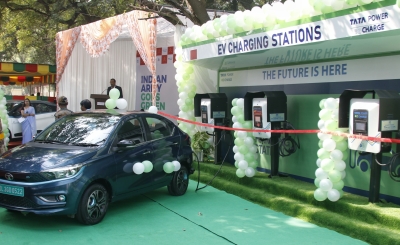India working with EV makers towards steady flow of rare earth magnets: Crisil
By IANS | Updated: June 10, 2025 11:43 IST2025-06-10T11:39:17+5:302025-06-10T11:43:31+5:30
New Delhi, June 10 As diversification of supply sources is being actively explored, aligned with policy efforts, the ...

India working with EV makers towards steady flow of rare earth magnets: Crisil
New Delhi, June 10 As diversification of supply sources is being actively explored, aligned with policy efforts, the situation continues to evolve for the Indian automotive players in their quest to have a steady flow of rare earth magnets amid China’s export restrictions, a Crisil report showed on Tuesday.
Rare earth magnets, low in cost but critical in function, could emerge as a key supply-side risk for the India’s automotive sector if China’s export restrictions and delays in shipment clearances persist.
A disruption lasting beyond a month can impact electric vehicle (EV) launches, affect production and weigh on the sector’s growth momentum, said the Crisil Ratings report.
Recognising the risk, the government and automakers are taking action on two fronts.
In the short term, the focus is on building strategic inventories, tapping alternative suppliers and accelerating domestic assembly under Production Linked Incentive schemes.
For the long term, reducing import dependency will hinge on fast-tracking rare earth exploration, building local production capacity and investing in recycling infrastructure.
“Despite contributing less than 5 per cent of a vehicle’s cost, these magnets are indispensable for EV motors and electric steering systems. Automakers are actively engaging with alternative suppliers in countries such as Vietnam, Indonesia, Japan, Australia, and the US, while also optimising existing inventories,” said Poonam Upadhyay, Director, Crisil Ratings.
In a constrained supply scenario, magnets may also get diverted to ICE models, which require fewer units, potentially impacting EV growth, she added.
Rare earth magnets are integral to permanent magnet synchronous motors (PMSMs) used in EVs for their high torque, energy efficiency and compact size. Hybrids also depend on them for efficient propulsion. In internal combustion engine (ICE) vehicles, the use of rare earth magnets is largely limited to electric power steering and other motorised systems.
In April, China which is the world’s dominant exporter of rare earth magnets imposed export restrictions on seven rare earth elements and finished magnets, mandating export licences.
The revised framework demands detailed end-use disclosures and client declarations, including confirmation that the products will not be used in defence or re-exported to the US.
With the clearance process taking at least 45 days, this added scrutiny has significantly delayed approvals. And the growing backlog has further slowed clearances, tightening global supply chains.
India, which sourced over 80 per cent of its 540 tonne magnet imports from China last fiscal, has started to feel the impact.
The supply squeeze comes just as the auto sector is preparing for aggressive EV rollouts.
Over a dozen new electric models are planned for launch, most built on PMSM platforms.
“While most automakers currently have 4-6 weeks of inventory, prolonged delays could start affecting vehicle production, with EV models facing deferrals or rescheduling from July. A broader impact on two-wheelers (2W) and ICE PVs may follow if the supply bottlenecks persist for an extended period,” said Anuj Sethi, Senior Director, Crisil Ratings.
Disclaimer: This post has been auto-published from an agency feed without any modifications to the text and has not been reviewed by an editor
Open in app